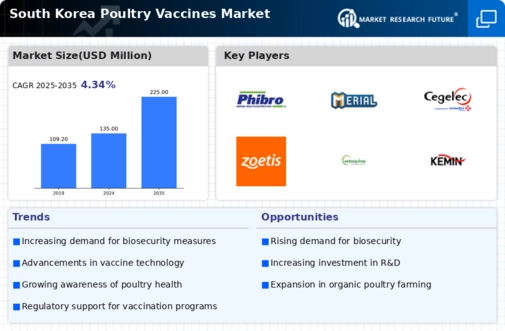Government Initiatives and Funding
Government initiatives play a crucial role in shaping the poultry vaccines market in South Korea. The government has implemented various programs aimed at enhancing poultry health and biosecurity. Financial support for vaccination campaigns and research into new vaccine development is becoming increasingly common. For instance, the Ministry of Agriculture, Food and Rural Affairs has allocated substantial funding to support vaccination efforts against prevalent poultry diseases. This financial backing not only encourages farmers to adopt vaccination practices but also stimulates research and development in the poultry vaccines market. As a result, the market is likely to benefit from increased innovation and the introduction of more effective vaccines, which could lead to a more resilient poultry industry in South Korea.
Rising Incidence of Poultry Diseases
The poultry vaccines market in South Korea is experiencing growth due to the increasing incidence of poultry diseases. Outbreaks of avian influenza and Newcastle disease have raised concerns among poultry farmers, prompting them to invest in vaccination programs. The South Korean government has reported a rise in disease outbreaks, which has led to a heightened focus on biosecurity measures. Consequently, the demand for effective vaccines is expected to increase, as farmers seek to protect their flocks and ensure the safety of poultry products. This trend indicates a robust market potential for vaccine manufacturers, as they develop innovative solutions to combat these diseases. The poultry vaccines market is likely to see a compound annual growth rate (CAGR) of around 6% over the next few years, driven by the need for disease prevention and control.
Consumer Awareness and Health Concerns
Consumer awareness regarding food safety and health is significantly influencing the poultry vaccines market in South Korea. As consumers become more informed about the potential risks associated with poultry diseases, there is a growing demand for safe and healthy poultry products. This trend is prompting poultry producers to prioritize vaccination as a means of ensuring the health of their flocks. The poultry vaccines market is likely to expand as producers seek to meet consumer expectations for high-quality, disease-free products. Surveys indicate that over 70% of consumers express concern about the safety of poultry products, which further drives the need for effective vaccination strategies. This heightened awareness among consumers is expected to create a favorable environment for the poultry vaccines market, encouraging producers to invest in vaccination programs.
Technological Innovations in Vaccine Development
Technological innovations are transforming the poultry vaccines market in South Korea. Advances in biotechnology and genetic engineering are leading to the development of more effective and targeted vaccines. These innovations not only enhance the efficacy of vaccines but also reduce the time required for their development. The introduction of recombinant vaccines and vector-based vaccines is becoming more prevalent, offering improved protection against specific pathogens. As a result, the poultry vaccines market is likely to witness an influx of new products that cater to the evolving needs of poultry farmers. The adoption of these advanced technologies may also lead to cost reductions in vaccine production, making them more accessible to a broader range of poultry producers. This trend suggests a dynamic and rapidly evolving market landscape.
Increasing Poultry Production and Export Opportunities
The growth of poultry production in South Korea is a significant driver for the poultry vaccines market. As the demand for poultry meat continues to rise, producers are expanding their operations to meet both domestic and international needs. This expansion creates a greater need for effective vaccination programs to ensure flock health and productivity. Additionally, South Korea's efforts to enhance its poultry export capabilities are further fueling the demand for vaccines. The government has set ambitious targets for poultry exports, which necessitates maintaining high health standards in poultry production. Consequently, the poultry vaccines market is likely to benefit from this increased production and export focus, as farmers seek to implement comprehensive vaccination strategies to safeguard their flocks and enhance their competitiveness in the global market.





















Leave a Comment